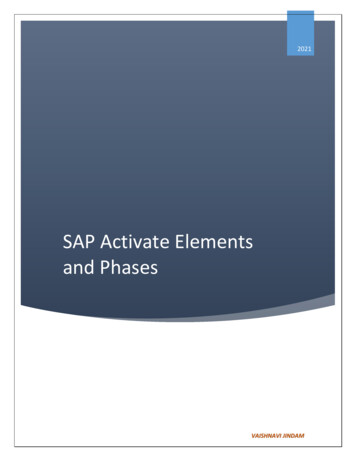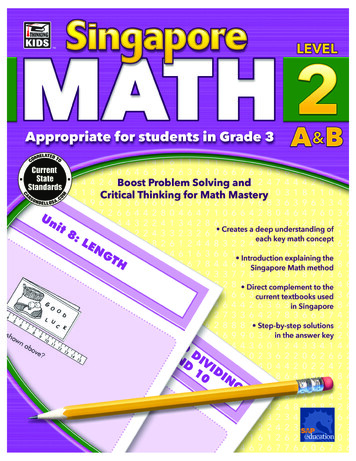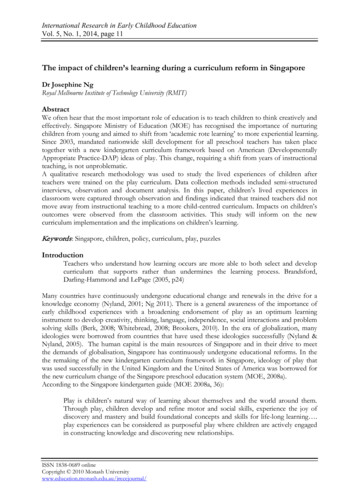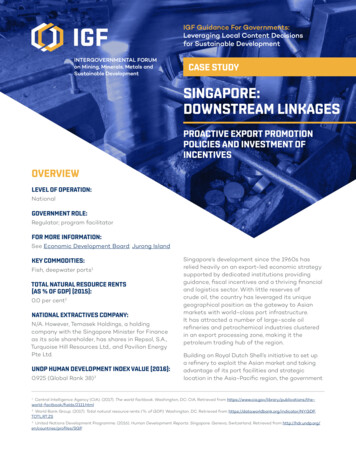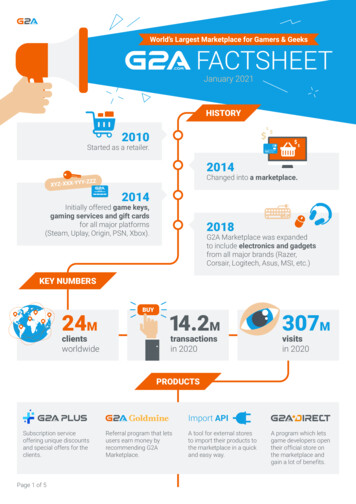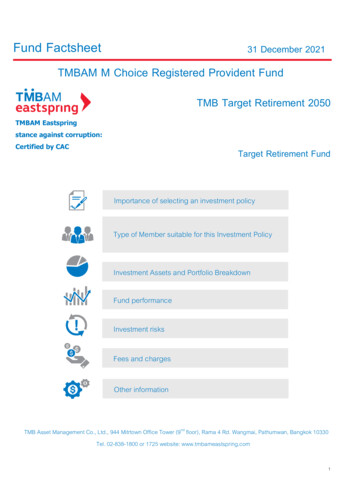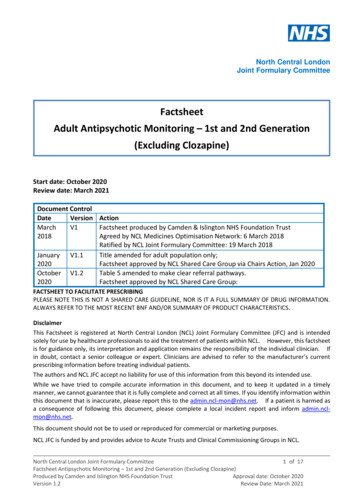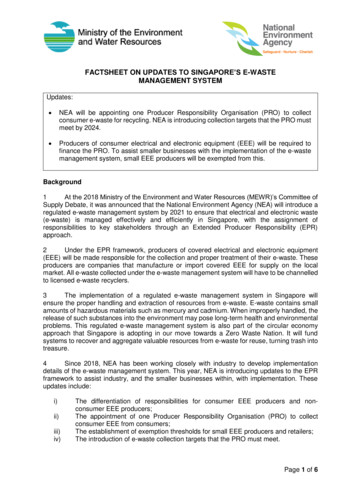
Transcription
FACTSHEET ON UPDATES TO SINGAPORE’S E-WASTEMANAGEMENT SYSTEMUpdates: NEA will be appointing one Producer Responsibility Organisation (PRO) to collectconsumer e-waste for recycling. NEA is introducing collection targets that the PRO mustmeet by 2024. Producers of consumer electrical and electronic equipment (EEE) will be required tofinance the PRO. To assist smaller businesses with the implementation of the e-wastemanagement system, small EEE producers will be exempted from this.Background1At the 2018 Ministry of the Environment and Water Resources (MEWR)’s Committee ofSupply Debate, it was announced that the National Environment Agency (NEA) will introduce aregulated e-waste management system by 2021 to ensure that electrical and electronic waste(e-waste) is managed effectively and efficiently in Singapore, with the assignment ofresponsibilities to key stakeholders through an Extended Producer Responsibility (EPR)approach.2Under the EPR framework, producers of covered electrical and electronic equipment(EEE) will be made responsible for the collection and proper treatment of their e-waste. Theseproducers are companies that manufacture or import covered EEE for supply on the localmarket. All e-waste collected under the e-waste management system will have to be channelledto licensed e-waste recyclers.3The implementation of a regulated e-waste management system in Singapore willensure the proper handling and extraction of resources from e-waste. E-waste contains smallamounts of hazardous materials such as mercury and cadmium. When improperly handled, therelease of such substances into the environment may pose long-term health and environmentalproblems. This regulated e-waste management system is also part of the circular economyapproach that Singapore is adopting in our move towards a Zero Waste Nation. It will fundsystems to recover and aggregate valuable resources from e-waste for reuse, turning trash intotreasure.4Since 2018, NEA has been working closely with industry to develop implementationdetails of the e-waste management system. This year, NEA is introducing updates to the EPRframework to assist industry, and the smaller businesses within, with implementation. Theseupdates include:i)ii)iii)iv)The differentiation of responsibilities for consumer EEE producers and nonconsumer EEE producers;The appointment of one Producer Responsibility Organisation (PRO) to collectconsumer EEE from consumers;The establishment of exemption thresholds for small EEE producers and retailers;The introduction of e-waste collection targets that the PRO must meet.Page 1 of 6
v)The inclusion of Electric Mobility Devices (EMDs) to the list of products in thecategory of large appliances covered under the regulated e-waste managementsystem.E-waste management system for consumer EEECollection of e-waste through one PRO, in-store collection points and take-back services5Consumer EEE refers to equipment largely marketed to and bought or used by thegeneral public (e.g. laptops, mobile phones and household appliances). For the collection ofconsumer EEE, NEA will be appointing one PRO to develop and implement a system for thecollection and recycling of the e-waste on the behalf of producers. The PRO will be appointedthrough an open tender, and the winning bidder will be required to develop public educationprogrammes to encourage the public to recycle e-waste, provide avenues whereby the publiccan send their e-waste for recycling (e.g. scheduled collection drives and e-waste bins in publicareas), collect and transport the e-waste to NEA-licensed e-waste recyclers, and report thetonnage of e-waste collected and recycled to NEA.6The PRO will be responsible for meeting e-waste collection targets set by NEA. NEAhas set the collection targets at 60 per cent of the put-to-market EEE weight for large householdappliances, and 20 per cent of the put-to-market EEE weight for the rest of the coveredconsumer EEE products that the PRO will be responsible for (excluding non-consumer EEE).Please refer to Annex A for a summary of the collection targets. As a transitional measure,penalties for missing enforcement targets will not be imposed in the first three years.7All retailers of covered consumer EEE will also be required to provide free one-for-onetake-back services during delivery. Large EEE retailers with EEE sales area above 300m2 willbe required to set up in-store e-waste collection points for ICT equipment, lamps and batteries,and ensure the e-waste is properly treated by licensed e-waste recyclers or the PRO.Exemption thresholds for small EEE producers and retailers8The PRO will be financed by the producers of consumer EEE in proportion to theirmarket share. The producers will hence be required to report to NEA the tonnage of coveredEEE that they put to market. NEA will be implementing measures to minimise the potential costimpact to small EEE producers and retailers. Producers supplying less than a specifiedthreshold amount of covered EEE to the local market will be exempted from financing the PRO.These producers are only required to register with NEA and report the amount of covered EEEthey supply to the local market annually. Likewise, retailers with an EEE sales area of 300m2 orless will be exempted from setting up in-store collection points. Please refer to Annex B for theexemption thresholds of the covered products.Expansion of product coverage to include electric mobility devices9Previously, NEA had announced that the covered EEE products under the system wereinfo-communication technology equipment, large appliances, batteries, lamps and solar panels.In view of the anticipated demand to dispose of electric mobility devices (EMDs) and the needfor their proper treatment of EMD batteries, NEA will be adding EMDs - which include PersonalMobility Devices (PMDs), Power Assisted Bicycles (PABs) and Electric Mobility Scooters (EMS)- to the list of products in the category of large appliances covered under the system. Allproducers of EMDs will be required to finance the PRO to collect end-of-life EMDs for recycling.Page 2 of 6
E-waste management system for non-consumer EEE10Non-consumer EEE refers to commercial and industrial equipment largely marketed andsold to businesses (e.g. solar panels and data servers). To provide businesses with an avenueto properly dispose of their e-waste, all producers of non-consumer EEE will be required toprovide free take-back of all of their end-of-life equipment from their clients upon request. Therewill hence be no exemption thresholds for the producers of such equipment covered under thesystem. To complement this obligation, businesses are also required to properly dispose of ewaste with the producer of the EEE or any licensed e-waste recycler.11Please refer to Annex C for a summary of the main responsibilities of the stakeholders.- End -For media queries, please contact:Kei Yamada (Ms)Corporate CommunicationsNational Environment AgencyTel: 6731 9122 / 9799 3154Email: kei yamada@nea.gov.sgDominic Seow (Mr)Corporate CommunicationsNational Environment AgencyDID: 6731 9214 / 9066 4418Email: dominic seow@nea.gov.sgPage 3 of 6
ANNEX AE-waste collection targets for appointed PROProduct CategoryProduct TypeCollection TargetPrintersPersonal Computers / LaptopsICT Equipment20% of PTM1 by weightMobile Phones / TabletsRouters / Modems / Set-top boxesRefrigeratorsAir-conditionersWashing Machines60% of PTM by weightLarge AppliancesDryersTelevisionsElectric Mobility Devices20% of PTM by weightLampsAll types20% of PTM by weightBatteries (Portable)All types20% of PTM by weight1PTM (put-to-market) refers to the amount of electrical and electronic equipment the producers supplyto the market.Page 4 of 6
ANNEX BExemption thresholds for producers of electrical and electronic equipmentProduct CategoryProduct TypePut-to-Market ThresholdPrintersPersonal Computers / LaptopsICT EquipmentMobile Phones / Tablets 10 tonnesRouters / Modems / Set-top BoxesRefrigeratorsAir-conditionersWashing Machines 100 tonnesDryersLarge AppliancesTelevisionsN.A.Electric Mobility DevicesAll producers of electricmobility devices will need tofinance the PRO.Portable Batteries 3 tonnesHybrid / Electric Vehicle Batteries 15 tonnesN.A.BatteriesIndustrial BatteriesLampsAll typesAll producers of industrialbatteries will need to offerfree take-back of all of theirend-of-life equipment fromtheir clients upon request. 3 tonnesN.A.Solar PV PanelsAll typesAll producers of solar PVpanels will need to offer freetake-back of all of their endof-life equipment from theirclients upon request.Producers supplying less than the specified threshold amount of covered EEE to the local market willbe exempted from financing the PRO. These producers are only required to register with NEA andreport the amount of covered EEE they supply to the local market annually.Page 5 of 6
ANNEX CSummary of main responsibilities for key e-waste stakeholdersKey StakeholderMain ResponsibilitiesProducers ofconsumer EEE Register with NEA.Producers of nonconsumer EEE Report amount ofelectrical and electronicequipment (EEE) put-tomarket to NEA. Finance PRO appointed byNEA. Smaller producers areexempted from thisrequirement. Required to provide free takeback of all of their end-of-lifeequipment from their clientsupon request. Report amount of e-wastecollected and sent for propertreatment to NEA. Adhere to licensing requirements.ProducerResponsibilityOrganisations (PROs) Develop and implement system(s) for the collection andrecycling of e-waste, as well as e-waste public educationprogrammes. Meet NEA’s collection targets. Collect and transport e-waste to NEA licensed recyclers. Report collection and recycling tonnage to NEA. Audit producers and contracted service providers. Provide free collection on a 1:1 basis whenever goods aredelivered.EEE Retailers Large retailers with more than 300 m2 of EEE sales area toregister and establish in-store collection point for small ewaste. Send collected e-waste to PRO / recycler. Participate in public education programmes. Adhere to licensing requirements. Meet recycling requirements.E-waste Recyclers Keep proper records of entire e-waste treatment process. Submit reports of amount of e-waste received and materialsprocessed/recycled to NEA.Page 6 of 6
E-waste management system for non-consumer EEE 10 Non-consumer EEE refers to commercial and industrial equipment largely marketed and sold to businesses (e.g. solar panels and data servers). To provide businesses with an avenue to properly dispose of their e-waste, all producers of non-consumer EEE will be required to

